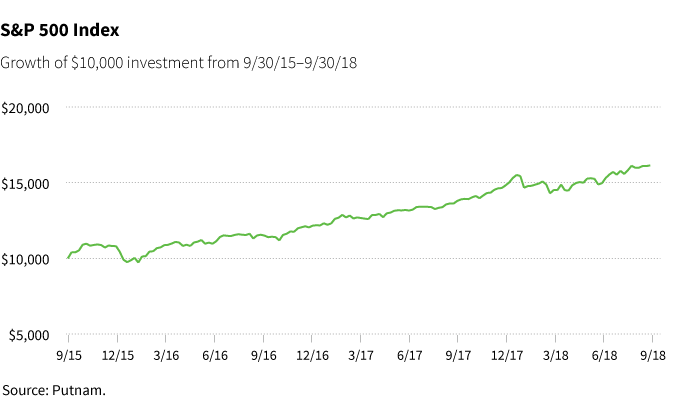- Stock market volatility since late September has parallels with a similar period near the beginning of 2016.
- The market's rotation to more reasonably valued defensive stocks seems appropriate given new questions about global growth.
- Third-quarter corporate earnings reports offer indications of whether the market is at peak earnings.
Since closing at a peak just above 2900 on September 20, 2018, the S&P 500 fell nearly 10% by the market’s close on October 24. This October volatility has shaken investors who have become accustomed to generally calmer markets over the past few years.
Parallels — and differences — with late 2015
Market moves over the past few weeks lead us to a comparison of late 2015 and early 2016, when the market fell into near-correction territory.

We saw similar shifts in investor appetite out of cyclical stocks and into defensive companies, regardless of fundamental merit or attractive valuations; this is a textbook reaction to volatility. However, we were more confident in a strong rebound in 2016 than we are now. We observe the following differences now that make us more cautious:
- Relative valuation in cyclicals vs. defensives
- Fed activity
- Oil prices
- Diversion in global growth
- Geopolitical pressures
Regarding relative valuation, during 2018 we have noticed that defensively oriented stocks have been more attractively valued and felt the market was appropriately pricing their fundamental prospects. This is the opposite of how we felt heading into 2016, when defensive names were significantly overpriced. The market shift into reasonably valued defensive stocks over the past few weeks (stocks with a high dividend yield, for example, have been notable outperformers) feels like an appropriate move that may not immediately reverse should sentiment improve slightly.
Global growth today is more uncertain
Current markets now are pricing in the fact that global growth has diverged. China is slowing, European markets never rebounded as we hoped, and now we question the durability of growth in the United States. Geopolitical events and U.S. policy have introduced even more challenges, particularly as the United States embarks on a trade war that could have real implications for U.S. corporate earnings. Oil prices have more than doubled on a per barrel basis. And finally, the Federal Reserve has officially moved into a tightening stance. This not only changes the outlook for growth and credit expansion going forward, but also serves as a regulating mechanism that can take the “frothiness” out of the markets.
We’re active in this — and all — markets
The corporate earnings reports now being released provide real data points that can give us an indication of whether the market is really at peak earnings. While some results have disappointed, we would note that companies that report this early in the season tend to be those that are ultra-sensitive to the economic cycle. As we progress through more reports, we will get an indication of how companies are being impacted by factors mentioned earlier. Additionally, through management guidance, we will see how company leaders view the future. It’s important to note that some companies continue to beat investor expectations.
Putnam portfolio managers are watching developments closely, continuing to discuss and share information across our investment groups, and determining what shifts are necessary in the portfolios. We are active both in assessing our conviction in current holdings and in identifying new opportunities that may arise from a temporary dislocation. You can read our views about inflation, the risks emanating from Italy's budget impasse, and concerns about the flattening yield curve and a downturn in housing and auto sales.
314211
For informational purposes only. Not an investment recommendation.
This material is provided for limited purposes. It is not intended as an offer or solicitation for the purchase or sale of any financial instrument, or any Putnam product or strategy. References to specific asset classes and financial markets are for illustrative purposes only and are not intended to be, and should not be interpreted as, recommendations or investment advice. The opinions expressed in this article represent the current, good-faith views of the author(s) at the time of publication. The views are provided for informational purposes only and are subject to change. This material does not take into account any investor’s particular investment objectives, strategies, tax status, or investment horizon. Investors should consult a financial advisor for advice suited to their individual financial needs. Putnam Investments cannot guarantee the accuracy or completeness of any statements or data contained in the article. Predictions, opinions, and other information contained in this article are subject to change. Any forward-looking statements speak only as of the date they are made, and Putnam assumes no duty to update them. Forward-looking statements are subject to numerous assumptions, risks, and uncertainties. Actual results could differ materially from those anticipated. Past performance is not a guarantee of future results. As with any investment, there is a potential for profit as well as the possibility of loss.
Diversification does not guarantee a profit or ensure against loss. It is possible to lose money in a diversified portfolio.
Consider these risks before investing: International investing involves certain risks, such as currency fluctuations, economic instability, and political developments. Investments in small and/or midsize companies increase the risk of greater price fluctuations. Bond investments are subject to interest-rate risk, which means the prices of the fund’s bond investments are likely to fall if interest rates rise. Bond investments also are subject to credit risk, which is the risk that the issuer of the bond may default on payment of interest or principal. Interest-rate risk is generally greater for longer-term bonds, and credit risk is generally greater for below-investment-grade bonds, which may be considered speculative. Unlike bonds, funds that invest in bonds have ongoing fees and expenses. Lower-rated bonds may offer higher yields in return for more risk. Funds that invest in government securities are not guaranteed. Mortgage-backed securities are subject to prepayment risk. Commodities involve the risks of changes in market, political, regulatory, and natural conditions. You can lose money by investing in a mutual fund.
Putnam Retail Management.









